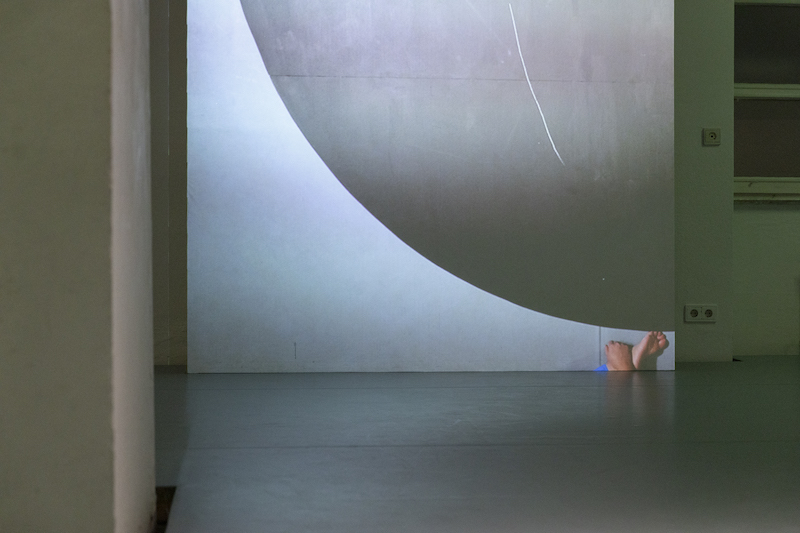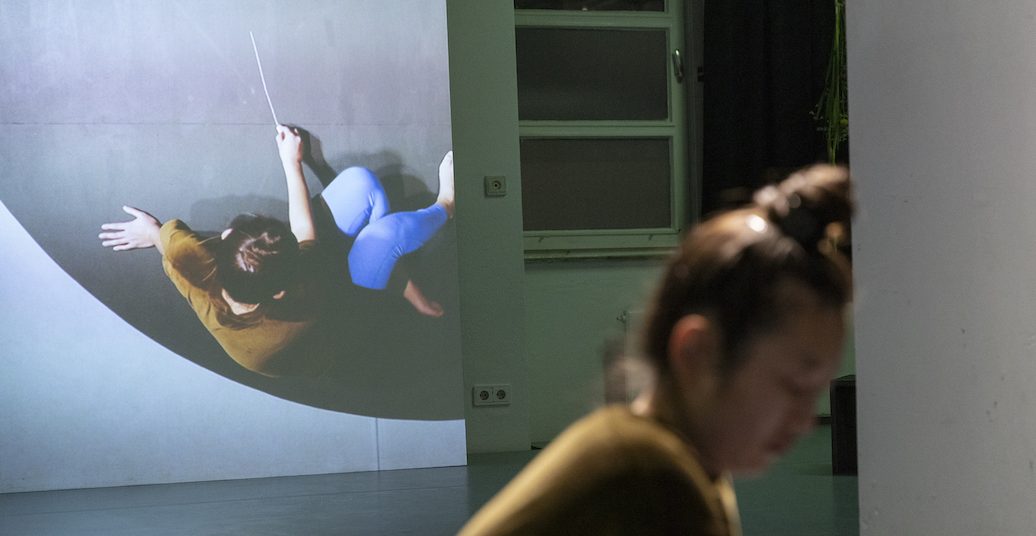Choreographer Johanna Ackva presented the restaging of “CLOUDS ON CLEAR SKY,” the result of an ongoing engagement with death and dying, at the interdisciplinary venue Vierte Welt at Kottbusser Tor from 6 to 9 October 2022. This fourth and final part of the solo series was created in collaboration with dancer Akemi Nagao.
Triggered by a potentially life-threatening accident from which she escaped through pure luck with only minor injuries, Johanna Ackva has been working with death, grief, and mortality for many years. Part of her approach has included conversations with people who have dedicated their lives to death, such as a funeral speaker, a death doula, and a cemetery gardener. Several artistic projects have already emerged from this research. The most recent is the series “CLOUDS ON CLEAR SKY,” which was created in 2021 as part of a residency at Vierte Welt. In dialogue with emeka ene, Regina Baumgart, Jan Burkhardt, and Akemi Nagao, the choreographer developed four solos in which each dancer developed their own approach to the themes through their respective somatic practices.
The evening begins with a transition: we take a short walk from Vierte Welt’s bar, a last gesture to the nightlife synonymous with Kotti, to the performance space, where for the next 45 minutes all worldly references will be blurred. The space, according to standards of visibility most audiences expect in a performance, is provocative from the first: four wide columns standing in the middle of the room make it impossible for a person perched on any one of the stools distributed all around to see everything that happens. One of the columns rests on a black, circular foundation, like a miniature stage, which marks the slightly shifted centre of the room. Apart from two bouquets of flowers hanging in front of a black cloth opposite the entrance, the scenography (environmental design/costumes: Bettina Mileta) is characterized by asymmetrical, fragmentary shapes and arrangements. Two cameras (video: Max Hilsamer) capture small sections of the space, which are projected onto fragmented screens over the course of the performance. The desire for a complete picture will remain unfulfilled until the end.
Akemi Nagao, wearing gold and blue, begins the performance sitting in the audience, so that she cannot be immediately identified as the protagonist of the evening. After a while she rises and begins to walk through every nook and cranny of the room, her movements meditative and slow. She seems to bestow equal attention on all human and non-human entities, interrupted only by an occasional soft smile. Her meticulous micro-movements map the space, referring to more dimensions than I am able to access directly. Through her fingers, her toes, and her mouth (which she keeps half-opening as she moves), Nagao’s body seems to become a multi-sensory antenna transmitting a topography of the invisible, the outlines of which I only had a vague idea by the end of the performance. Then suddenly we hear sound fragments (music: Evelyn Saylor), which in this context are reminiscent of the acoustic emissions of a seismograph. Initially, the sounds make me think of a whistle developing in the direction of a pleasant melody only to dissolve into fragments shortly before achieving harmony. Strangely enough, over time the sounds, which at first seem abstract, transmit an increasingly concrete sense of the sphere which Nagao seems to be probing. At this point, what is perhaps the only clear thought I have during the performance surfaces (and then immediately dissolves into the unrecognizable noises coming from the loudspeaker): the analogy between sound, which the musician Mieko Suzuki described as an invisible energy with great effect in the context of the project “Unacknowledged Loss,” and death, as an elusive phenomenon whose effects are ever-present and yet which we experience for the most part as incomprehensible noise—
While the piece acoustically refuses to become more concrete, Akemi Nagao resists absence. As the title implies, “CLOUDS ON CLEAR SKY” explores the different facets of the (in)visible. Due to the space’s particular architecture, my perceptions of Nagao are often only fragmented or mediated: I see her alternately as a shadow on the wall, filmed from above and projected onto the large screen behind me, reflected in the windows, as an asynchronous video recording from the past layered onto the present, or even in the eyes of the other viewers. And even in the brief moments when I can’t see her anywhere, I would have to close my eyes and ears to make her hyperpresence disappear.
In the last scene Nagao starts to draw—but before she has really started, she stops again and returns to her seat in the audience. This concludes the performance, leaving behind many unfinished emotions and thoughts as well as a white chalk sketch on a black background, which in its abstract form seems strangely familiar.

Picture: “CLOUDS ON CLEAR SKY”, Johanna Ackva & Akemi Nagao ©Uta Neumann
English translation by Cory Tamler
“CLOUDS ON CLEAR SKY”is a series of dance performances resulting from a longterm investigation into experiences around death, mourning, and finiteness as a reality at the very core of life by choreographer Johanna Ackva. The solo with Akemi Nagao could be seen on 9 October 2022 at the Vierte Welt in Berlin-Kreuzberg.




